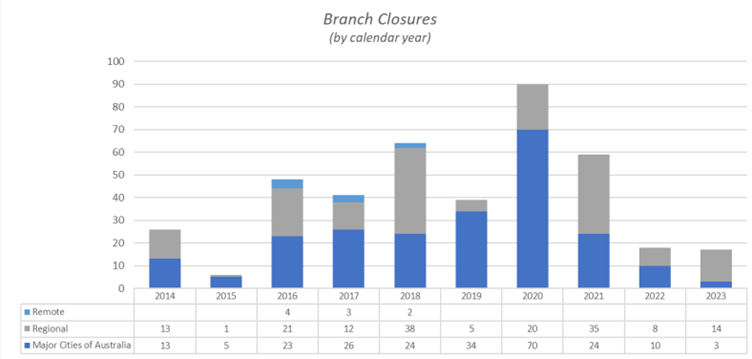

Following questions from a public hearing, ANZ has admitted that 16 of its regional branch closures since 2014 left some residents with no nearby banking options, reigniting concerns about financial service accessibility in rural areas.
The answers come after more than 1,200 bank branches closed across regional towns in six years, sparking a public discussion and a separate senate inquiry into the major banks’ transition towards digital banking.
In July, bank executives were quizzed about their operations during a public hearing held by the House of Representatives Standing Committee on Economics as part of its review into Australia’s big four banks.
The questions addressed to ANZ covered several subjects, ranging from the bank’s approach to assessing lending for renewable energy projects to how it deals with scams and detects fraudulent activity in its accounts.
On January 10, ANZ addressed these questions, including answering what factors the bank considered when deciding how many and which bank branches to close.
“Closing a branch is never a decision taken lightly and we carefully consider a number of factors,” the submission said.
“This includes analysing (often over a long period of time) how many consumer and business customers are visiting a branch, how they’re using it – including the volume of transactions – and what alternative banking options are available for customers.”
As part of this analysis, ANZ said it looks at customer behaviour data, including whether customers are transacting from their nearest regional hub or centre – and how many branch customers are regularly using ATMs, phone, or digital banking (such as the ANZ App and internet banking).
“We also consider the number of new home loans and deposit accounts established through a branch to help us understand the level of other ‘non-transaction’ interactions in that branch.”
Far from the worst offender, ANZ, the smallest of the big four, has closed 408 branches in the last decade, including 17 in 2023.
The vast majority (253 branches, including 105 that were regional or remote) were closed between 2018 and 2021 during a time when bank branches generally were closing at a rate of 15 per month.
By September 2023, the bank had 390 branches across the country – 140 of those in regional areas.

Note: Figures are as at branch closure date for ANZ branches. The closure may have been announced in the prior year (e.g. the 14 regional closures in 2023 were announced in 2022). ANZ classifies branch locations as remote, regional, and major cities of Australia in accordance with ABS guidelines.
By comparison, about 420 bank branches across Australia closed in the year to June 2023, including 122 branches regional and remote areas.
This downward trend has been seen in regional and remote areas, with branch numbers declining by 34% and by 37% across the country compared to data gathered in June 2017.
However, the increased pressure on banks has certainly slowed the momentum of closures, with CBA and Westpac having committed to no bank closures while the senate inquiry continues.

It’s important to note that bank branch closures are not a bad thing by themselves. As addressed by ANZ, banks may have legitimate reasons why they are closing a branch.
Echoing what NAB managing director and CEO Ross McEwan said to the senate inquiry in September, banks are experiencing rapid changes in how customers interact with them and access their services and products.
“Digitisation has ushered in a new era of convenience, and we are all adapting to these dynamics,” McEwan said. “Today, 93% of interactions with our personal customers occur through digital channels – and this is growing – in fact, our data shows us that digital adoption is occurring at the same level in regional Australia as it is in metro areas.”
But while digital banking offers alternative options, not everyone has reliable internet access or is comfortable using digital platforms.
ANZ said there are currently 11 locations in Australia in regional and remote areas where its branch or agency is the only branch or agency presence.
And although the rest of the big four utilise Australia Post’s Bank@Post services to get around leaving remote and regional customers without another option, ANZ has not been successful in reaching a “fair and proportionate” agreement with the postal service.
Originally due on December 1, the senate granted an extension of time until the final report is made available until May 16. The committee also agreed to reopen submissions until February 29.
